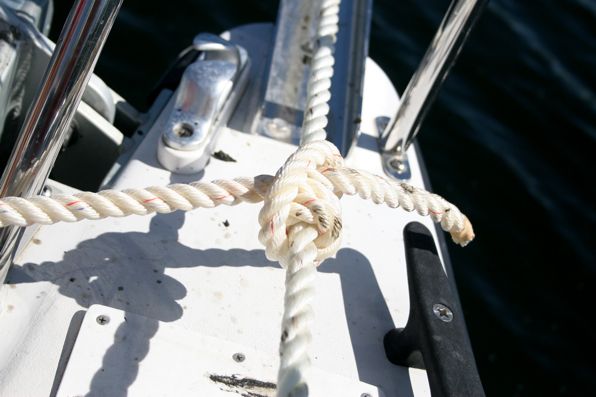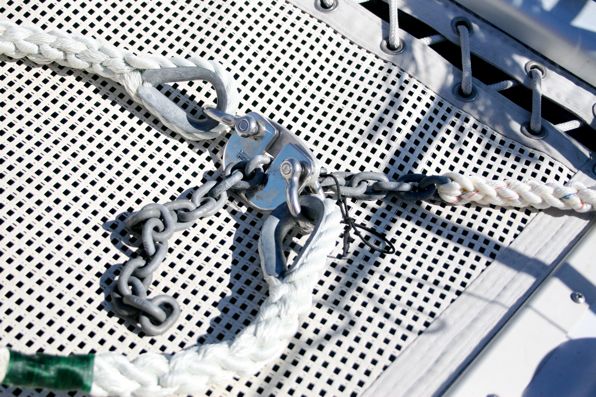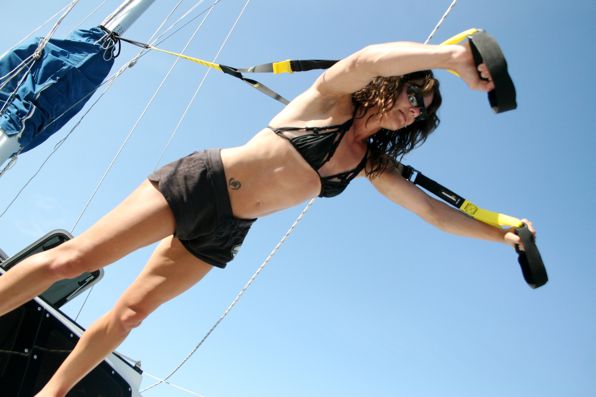Ghosting along
The destination for our sail yesterday was… west! West along Adolphus Reach with no real destination in mind. The winds were 5-10 and for much of the day, we were able to set the autopilot and ghost along on a nice broad reach.

There was a point shortly after we set out when it appeared we were on a collision course with another sailboat (a Nonsuch). We were both going so slow that it was hard to determine who was going to pass in front. We had the right of way though and thus were the stand on vessel. Although it took some discipline to do so, we held our course and by the time we crossed paths we were at least a couple of boat lengths apart. I don’t know how those racers do it any closer because it was stressful!
When I mentioned the other day about anchoring in deeper water, it was suggested (in the comments that followed) that there were several ways of rigging a bridal on the rope rode (as opposed to the chain). One method suggested, that I had already planned to rig up, was to splice a short length of chain onto a short length of line. The chain could fit through the chain plate we typically use when attaching to our chain rode and the line spliced onto it could be tied with a rolling hitch to the rope rode. Because I thought this was a clever idea, and so that I would have another chance to practice my splicing, I decided to make one up. Verdict? It works great.



The two pics below show how Rebecca and I both have very different ideas about how to relax…
 Me, trying to learn to play the new Ukulele given to me by my good friend Adam.
Me, trying to learn to play the new Ukulele given to me by my good friend Adam.

Rebecca, doing what comes naturally to her, exercising, with her TRX of course!
By the way, today is the beginning of the Atlantic Hurricane season. I hope that it turns out to be very uneventful for our friends in the Caribbean, and for ourselves as we make our way down the US East Coast.


Did you use the old rule for detecting collision risk?
From COLREGS
(d) In determining if risk of collision exists the following considerations shall be among those taken into account:
(i) Such risk shall be deemed to exist if the compass bearing of an approaching vessel does not appreciably change;
Basically as you’re coming up on the other vessel, if their bearing in relation to you is changing, you will avoid collision if you both maintain course and speed. But if the bearing is staying the same, you’re in trouble.
I know you probably know… Just thought I’d throw it out there for anyone that doesn’t. Enjoy your blog!
Tate
Thanks Tate. I appreciate the comments!
Because we are primarily sailing with land in sight, I like to use the following:
1. If I look at the bow of the vessel in question and it looks as if it is “eating up” the land in front of it, I know it should pass in front of us.
2. If the vessel appears as if it is “throwing up” land from its mouth, we should pass in front.
3. If neither of these are occurring then we are on a collision course.
In the case I described, it initially looked as if we were on a collision course. We monitored it and it changed, albeit only a bit, to show we would pass in front. We kept waiting for the other vessel to make an obvious course adjustment to indicate that he was aware that we were the stand on vessel (we were both on a port tack but we were the leeward vessel) but he didn’t.
Mike,
Not sure I follow #s 1 & 2. It seems like it should be the reverse doesn’t it (maybe I just can’t visualize it)? If you were out of sight of land, what would you do? FWIW, we pick out a stanchion on our boat. If the converging vessel is moving forward of the stanchion, it will pass in front, if it’s moving behind, we will pass in front and if it’s not changing then we are on a collision course. Note that frequently when on a collision course it looks like first you’re gaining and then you’re losing.
The other thing we have found in the islands is there are a lot of charterers who have no R-O-W clue (or they left their R-O-W brains at home). As a result, we take action early and often.
Fair Winds,
Mike
Sorry Mike. I had #1 written incorrectly. Please check it again. It is basically the same as the method you are describing. Of course, yours will work out of sight of land.
We have definitely had to alter course even though we were in the right. An example was with some racers who were healed over quite a bit and were all sitting on the rail. We knew they didn’t see us and thus altered course to pass behind them.
BTW, we expect sound clips of that new instrument you’re strumming on!
Also, Good point Mike Ratrie. We learned the compass bearing method with the mindset that land might not always be in sight. But an excellent counter point might be… What if you have no compass (God forbid). Well the stanchion idea is a great one I hadn’t thought of. Thanks for sharing the tip!
Yeah, when it is worth listening to I will. 🙂
HA! I love the eating/pooping phrase. We call it “making trees” as in “are we making trees with that boat”?
That makes sense to me to Livia.
Wow – 5.1 knots in 4.6 knots of wind! I am getting multihull envy!
bob
The wind “might” have just dropped prior to that pic but we were sailing for much of the day at 70% of wind speed and on several occasions when I checked, even better. The big genny obviously helps!
70-75% efficiency is always our goal when we’re on a reach. It’s fun to experiment and find that extra tenth of a knot here or there.
Rob
I enjoy tweaking the sails like that too. The challenge for me is determining what changes are having a positive effect when the wind speed keeps changing.
Was that true or apparent wind? It looks like apparent.
The goal I spoke of was ~ 70% of true wind.
Apparent is trickier; Up-wind at all, the number keeps growing. Hard to get a good percentage. Off the wind with the chute up, 100% of apparent is a good goal for a cruising boat. Sometimes, you can do a tick better.
My stiletto would do ~ 130% of true on a broad reach, or about 120% of apparent. The apparent wind remained ~50 degrees off the bow even when sailing 135 degrees off, and jibing was like tacking, with the wind passing in front of the boat! I miss her sometimes.
If you are referring to my pic it is true. I never set it to apparent as I have no idea how to trim for that.
Olympic dingy sailors don’t have instruments. No big deal.
The truth is, I haven’t had the knot meter connected since day one. Stuff grows to fast in the Chesapeake for it to be worth the bother. I go by tell tails, feel, and whether I am passing other boats longer than me.
It’s cruising, not racing!